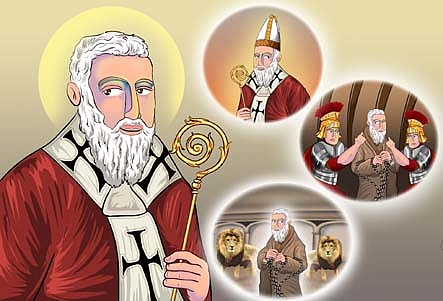Lessico
Sant'Ignazio di Antiochia
Vescovo di
Antiochia![]() e martire
(Siria 50 ca. – Roma tra il 98 e il 117), uno dei padri
apostolici della Chiesa. Detto anche Ignazio I l’Illuminatore.
Secondo successore di Pietro sulla cattedra di Antiochia, gli succedette Erone
e martire
(Siria 50 ca. – Roma tra il 98 e il 117), uno dei padri
apostolici della Chiesa. Detto anche Ignazio I l’Illuminatore.
Secondo successore di Pietro sulla cattedra di Antiochia, gli succedette Erone![]() .
Il primo successore di Pietro ad Antiochia fu Evodio, del quale sono incerte
le date dell'ordinazione e della morte: "But the
dates of his ordination and death are quite uncertain. No early witness makes
him a martyr. The Greeks commemorate together "Evodus" and
Onesiphorus (II Tim., i, 16) as of the seventy disciples and as martyrs on 29
April, and also on 7 September. Evodius was unknown to the earlier Western
martyrologies the Hieronymian, and those of Bede and Florus; but Ado
introduced him into the so-called "Martyrologium Romanum parvum" (which
he forged not long before 860) and into his own work, on 6 May. His source was
Pseudo-Ignatius, whom he quotes in the "Libellus de fest. Apost.",
prefixed to the martyrology proper. From him the notice came to Usuard and the
rest, and to the present Roman Martyrology."
(Catholic Encyclopedia)
.
Il primo successore di Pietro ad Antiochia fu Evodio, del quale sono incerte
le date dell'ordinazione e della morte: "But the
dates of his ordination and death are quite uncertain. No early witness makes
him a martyr. The Greeks commemorate together "Evodus" and
Onesiphorus (II Tim., i, 16) as of the seventy disciples and as martyrs on 29
April, and also on 7 September. Evodius was unknown to the earlier Western
martyrologies the Hieronymian, and those of Bede and Florus; but Ado
introduced him into the so-called "Martyrologium Romanum parvum" (which
he forged not long before 860) and into his own work, on 6 May. His source was
Pseudo-Ignatius, whom he quotes in the "Libellus de fest. Apost.",
prefixed to the martyrology proper. From him the notice came to Usuard and the
rest, and to the present Roman Martyrology."
(Catholic Encyclopedia)
Ignazio si faceva chiamare Teoforo (cioè portatore di Dio) e si ritiene sia stato discepolo di san Giovanni Evangelista. Durante il regno dell'imperatore romano Traiano (Italica, Spagna Betica, 53 - Selinunte, Cilicia, 117) fu condannato a essere divorato dalle bestie feroci.
Durante il percorso da Antiochia a Roma, dove ebbe luogo l'esecuzione, scrisse sette lettere, cinque delle quali indirizzate alle comunità cristiane di Efeso, Magnesia, Tralles, Filadelfia e Smirne, città dell'Asia Minore che avevano inviato rappresentanti a salutarlo al suo passaggio. Le altre lettere erano indirizzate a Policarpo, vescovo di Smirne, e alla comunità cristiana di Roma.
Le lettere contengono preziose informazioni sulle credenze e l'organizzazione della Chiesa cristiana primitiva: Ignazio ne fornì un'immagine vivida come comunità di amore raccolta intorno a un vescovo, assistito da un concilio di presbiteri e diaconi. Fu il primo scrittore cristiano a sottolineare la nascita virginale di Cristo e a usare il termine "Chiesa cattolica" per designare la collettività dei fedeli.
The character of St. Ignatius, as deduced from his own and the extant writings of his contemporaries, is that of a true athlete of Christ. The triple honor of apostle, bishop, and martyr was well merited by this energetic soldier of the Faith. An enthusiastic devotion to duty, a passionate love of sacrifice, and an utter fearlessness in the defense of Christian truth, were his chief characteristics. Zeal for the spiritual well-being of those under his charge breathes from every line of his writings. Ever vigilant lest they be infected by the rampant heresies of those early days; praying for them, that their faith and courage may not be wanting in the hour of persecution; constantly exhorting them to unfailing obedience to their bishops; teaching them all Catholic truth; eagerly sighing for the crown of martyrdom, that his own blood may fructify in added graces in the souls of his flock, he proves himself in every sense a true, pastor of souls, the good shepherd that lays down his life for his sheep. (Catholic Encyclopedia)
La sua festa ricorre il 20 dicembre nella Chiesa greca, il 1º febbraio in quella romana (altri riportano il 17 ottobre).
